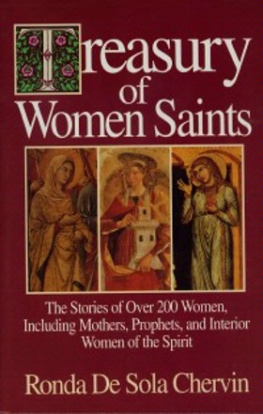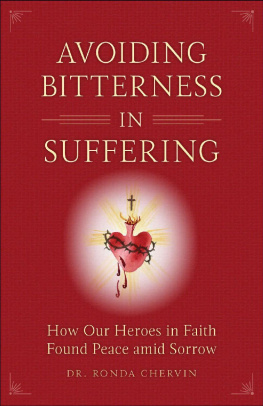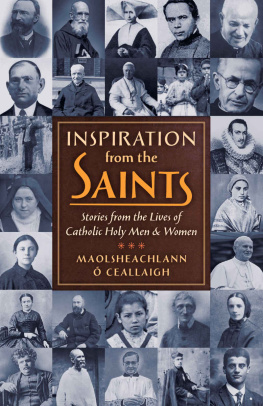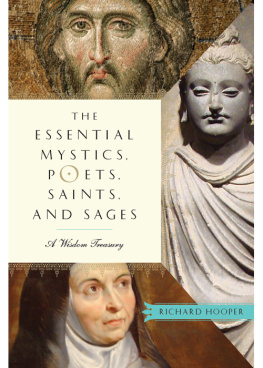Treasury ofWomen Saints
Ronda De SolaChervin

Copyright 1991 by Ronda DeSola Chervin
All rights reserved.
Published by ServantPublications
P.O. Box 8617
Ann Arbor, Michigan 48107 USA
TABLEOF CONTENTS
Introduction
"T here is only one tragedy , not to havebeen a saint," wrote French author Leon Bloy. How many saints through theages have been nourished not only by Holy Communion and Scripture, but also bycontact with living saints and the reading of the lives of past saints!
Certainly the saints in heaven,whose lives we read and who read our lives and intercede for us as we make ourown journeys toward eternity, play a great part in our spirituality. At baptismand confirmation we are given a saint to be our patron. Daily Mass-goers followthe annual feast days of the saints. Others see films about the most famous ofthan.
The goal of Treasury of Women Saints is to acquaint Christians withthe stories of many of these women, some familiar, all fascinating. Since myconversion from an atheistic background thirty years ago, it has been mypractice to read the lives of the saints as spiritual nourishment nightly. Itis a joy to tell their tales once more, and to inspire readers of these shortaccounts to read longer biographies. The women saints with whom I had not beenacquainted became new friends in heaven, each one's story illustrating gospeltruths with a new slant
A separate book about women saints is of special value in our times when so manyCatholic women are undergoing identity crises about their role in the churchand society. The true dignity of women, well shown by Pope John Paul II in hisApostolic Exhortation on the Dignity and Role of Women, consists precisely inthe love of God for each of us made in his divine image and likeness. Womensaints clearly exemplify how great a woman can become if she confides herdestiny totally to the God of infinite love and providential care. Realself-love, as the saints demonstrate, comes from doing "somethingbeautiful for God," as Mother Teresa of Calcutta has said, in one form oranother, at every moment of our lives.
The many differences between thewomen saints of country, era, lifestyle, and vocation provide models to whichevery contemporary woman, desiring complete union with Christ, can relatefruitfully. The imitation of the saints does not mean any kind of slavishfollowing of exterior details or even specific interior attitudes. As aspiritual director of mine once said when I was asking him to make me intoanother Catherine of Siena, "God already has St. Catherine, now he wantsSt. Ronda." What we want to imitate in the saints is their love, theirzeal, their intimacy with God, their astounding courage, their forgiveness, andtheir compassion.
The women saints are wonderfulcomrades, foremothers, and sisters to us all, whatever our sex. It is hopedthat Treasury of Women Saints willalso be read by men who need as much as women to be guided by the light thatemanates from holy women. It is said that women in general teach men how tolove. How much more is this true of women in intimate touch with divine love!
PRACTICAL USES OF THIS BOOK
The format of Treasury of Women Saints is a bit different from standardreference books on the saints. Lives are arranged by the categories of: youngsaints, motherly saints, martyrs, prophetic saints, interior women of theSpirit, and sinners turned saints. There is an alphabetical index at the end ofthe book I have also followed the lead of Joan Carroll
Cruz's fine book Secular Saints, byhaving an index of the particular type of sufferings endured by the saints sothat a reader with a particular cross might quickly be able to find holyfriends who went through the same difficulties.
The categories I havechosenyoung saints, mothers, martyrs, prophets, interior women of the Spirit,and penitentsare, of course, not mutually exclusive. St Therese of Lisieuxcould certainly be included under interior women rather than under youngsaints, but I chose to add her to the young saints because I think that heryouth is a real part of her charm. All women saints had a deep interior life,but with some this was the main aspect of their holiness, whereas others, suchas Blessed Marie of the Incarnation, seem to me to be energized as much bytheir motherliness toward the needy than by their beautiful mysticalexperiences, and so I have included her as a motherly saint.
By young saints I mean ones whodied at twenty-five or younger. I put them first, imagining that the book maybe read by mothers and daughters together and that young people might be drawnto follow the saints of other categories if they first are led to identify withsaints of their own age levels.
I designate certain saints asmotherly because it seems to me that it is the neediness, poverty, illness, andmisery of others that touched their hearts the most Their inner prayer livesinspired them with Christ's own love for the most helpless.
Of the martyrs, I have includedonly those who actually died because of their insistence on not betraying thecreed. Ones designated as martyrs by dying for moral uprightness, such as St.Maria Goretti, I have usually listed under young saints.
By the more unusual title ofprophetic saints I refer to women whose holiness was very public because theywere actual prophets of future calamities or were recognized as speaking forGod. This category also includes founders of religious orders who had to dealwith many persecutions in trying to bring about new forms of religious life, orwomen who had to stand up heroically and witness verbally to abuses of churchor society, or those whose main charism strikes me as creatively initiating newthings in the church.
By interior women of the Spirit Imean primarily those with a contemplative vocation whether they be cloistered,married, or single. The word mystical often used in my descriptions meanssimply a felt presence of God in any form, whether it be a gentle touch oflove, words from God audible or impressed into the heart, visions, levitations,or the stigmata.
It should be noted that althoughthe Virgin Mary is our perfect saint, intercessor, and model, she has not beenincluded because there are many lengthy books about her already. A cursorytreatment would be too unsatisfying to undertake or to read.
The penitential saints mayunnerve some readers, for their penances may seem so extreme as to berepulsive. It should be noted that these women who had given themselves tomortal sin in the past felt a much greater need for healing through reparationthan a saint whose sins are more in the nature of defects than of purposelychosen offenses against God. The main motive for penance, however, was to joinwith Christ in suffering for the sins of the world, as expiation. They wereaware of both the heinousness of sin and the goodness of God. Saints whoreceived this purity of heart understood the evil of sin and longed to sufferfor it with Christ as a sacrifice for the purification of the church.
I end the story of each saintwith some reflections of my own concerning how the charism of the particularsaint can be related to problems of our times. This is followed by a prayercomposed by myself, or, when possible, by lines from the writings of the saintor from a eulogy of her life written by an admirer.
Many readers Will want to usethis treasury as a daily devotional, reading an entry each day. The lifeapplications and the prayers and meditations, which have been provided in the"For Your Life" and "Prayer-Meditation" sections, areideally suited to such an approach. After reading the biographical sketch of aparticular saint, the reader could enter into a devotional time of reflectionand prayer, asking the Lord, "How does this saint's life apply to my own?What is the message I can take with me throughout my day?"
Next page











